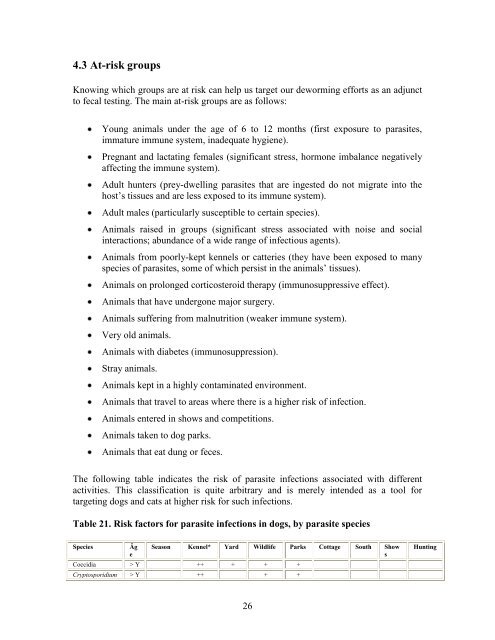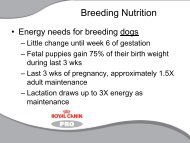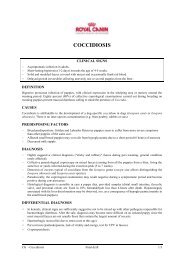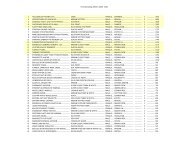Guide to Preventing Parasites.pdf - Royal Canin Canada
Guide to Preventing Parasites.pdf - Royal Canin Canada
Guide to Preventing Parasites.pdf - Royal Canin Canada
Create successful ePaper yourself
Turn your PDF publications into a flip-book with our unique Google optimized e-Paper software.
4.3 At-risk groups<br />
Knowing which groups are at risk can help us target our deworming efforts as an adjunct<br />
<strong>to</strong> fecal testing. The main at-risk groups are as follows:<br />
Young animals under the age of 6 <strong>to</strong> 12 months (first exposure <strong>to</strong> parasites,<br />
immature immune system, inadequate hygiene).<br />
Pregnant and lactating females (significant stress, hormone imbalance negatively<br />
affecting the immune system).<br />
Adult hunters (prey-dwelling parasites that are ingested do not migrate in<strong>to</strong> the<br />
host’s tissues and are less exposed <strong>to</strong> its immune system).<br />
Adult males (particularly susceptible <strong>to</strong> certain species).<br />
Animals raised in groups (significant stress associated with noise and social<br />
interactions; abundance of a wide range of infectious agents).<br />
Animals from poorly-kept kennels or catteries (they have been exposed <strong>to</strong> many<br />
species of parasites, some of which persist in the animals’ tissues).<br />
Animals on prolonged corticosteroid therapy (immunosuppressive effect).<br />
Animals that have undergone major surgery.<br />
Animals suffering from malnutrition (weaker immune system).<br />
Very old animals.<br />
Animals with diabetes (immunosuppression).<br />
Stray animals.<br />
Animals kept in a highly contaminated environment.<br />
Animals that travel <strong>to</strong> areas where there is a higher risk of infection.<br />
Animals entered in shows and competitions.<br />
Animals taken <strong>to</strong> dog parks.<br />
Animals that eat dung or feces.<br />
The following table indicates the risk of parasite infections associated with different<br />
activities. This classification is quite arbitrary and is merely intended as a <strong>to</strong>ol for<br />
targeting dogs and cats at higher risk for such infections.<br />
Table 21. Risk fac<strong>to</strong>rs for parasite infections in dogs, by parasite species<br />
Species Âg<br />
e<br />
Season Kennel* Yard Wildlife Parks Cottage South Show<br />
s<br />
Coccidia > Y ++ + + +<br />
Cryp<strong>to</strong>sporidium > Y ++ + +<br />
26<br />
Hunting







